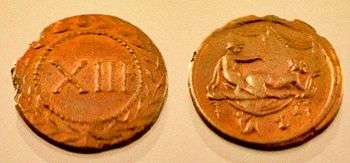Spintria

A spintria (plural, spintriae) is a small bronze or brass Roman token, possibly for use in brothels, usually depicting sexual acts or symbols.
Use
Some scholars have argued that spintriae were used to pay prostitutes. Under Caracalla, an equestrian was sentenced to death for bringing a coin with the emperor's likeness into a brothel; he was spared only by the emperor's own death.[1] There is no direct ancient evidence, however, to support the theory that spintriae were created as tokens for exchange in place of official coinage. Numismatist Theodore V. Buttrey suggests that they were used as game pieces.[2]
They may have been gaming tokens. They seem to have been produced for only a short period, mostly in the 1st century AD.
Appearance


There were usually struck from brass or bronze, and were little smaller than a U.S. quarter. The represented erotic plot was suitable for the provided services. Some of the coins depicted homosexual acts between men.
See also
Notes
- ↑ Cassius Dio 78.16.5.
- ↑ Thomas A. McGinn, The Economy of Prostitution in the Roman World (University of Michigan Press, 2004), p. 115.
References
- Lee, Bartholomew (Fall 1983). ""Brass Checks" Return: An Excursus in Erotic Numismatics, or The Spintriae Roll Again". The Journal of Popular Culture 17 (2): 142–145. doi:10.1111/j.0022-3840.1983.1702_142.x.
External links
Prime sources
- "Is that a spintria in your pocket, or are you just pleased to see me?", Geoffrey Fishburn, University of Queensland, Australia
- Straight Dope on spintria
- The Collaborative Numismatics Project -- dated
Images
- Selection from the extensive holdings of the Hunterian Collection, Glasgow